- Home
- Tom Clancy
Airborne: A Guided Tour of an Airborne Task Force Page 18
Airborne: A Guided Tour of an Airborne Task Force Read online
Page 18
This mortar uses the same M64 optical sight as the 60mm mortar, and the munitions types include high-explosive, smoke, illumination, and incendiary (white phosphorus). The high-explosive round weighs 4.2 kg. In service since 1986, the M252 is an adaptation of a British 81mm mortar developed in the 1970s. In the 82nd Airborne division, the M252 is found in a separate mortar platoon that is part of the heavy weapons company of each rifle battalion. A trained crew can get off thirty rounds per minute for two minutes, and then sustain up to fifteen rounds per minute as long as the ammunition supply lasts.
Heavy Direct-Fire Weapons
As with any military unit, airborne troops face threats from the entire spectrum of technology. The primary enemies to these soldiers (other than enemy infantry) are twofold: armor, which includes tanks and armored vehicles, and aircraft, which includes both fixed-wing and rotary-wing types.
During the Cold War, the West held a general superiority in aircraft, and many felt confident that the air forces of the NATO nations would be able to establish air superiority over the battlefield if hostilities were to have erupted in a NATO/Warsaw Pact clash. This was not the case, however, with tanks. The Warsaw Pact armies in general and the Russian Army in particular held such a vast numerical superiority over the NATO nations in tanks that there was little doubt that the American Army would be in deep trouble in any battle. To counter these threats, the American military began to build up an enormous stockpile of antitank weapons.
Today, these same weapons provide the 82nd Airborne with its last heavy direct-fire capability. This is because the M-8 AGS, which was to have replaced the aging M551 Sheridan light tank, was canceled in 1996. Then the Sheridan itself was ordered taken out of service. These measures were based upon a need to reprogram modernization funds for operational contingencies, which is a fancy way of saying “the Bosnia Peacekeeping Force.” As such, it is the lighter XVIII Airborne Corps formations like the 82nd Airborne and the 2nd Armored Cavalry Regiment (Light) which have paid the price for these ill-considered budget decisions. It remains to be seen if that price will involve dead troopers.
BGM-71 TOW Anti-Tank Missile
The first major break for the U.S. Army in the field of antitank missiles was the TOW (Tube-Launched, Optically Tracked, Wire-Guided) antitank missile. Manufactured by Hughes Aircraft Company, and given the code name BGM-71, this heavy antitank missile first entered service in 1970. Since then, TOW has continued on as the premier heavy antitank missile operated by the Army. What the TOW did for the Army was enable any small vehicle, from a jeep to an armored personal carrier, to engage and defeat an enemy main battle tank, thus evening the balance of power for allied land forces. Today’s version of the TOW is very similar to those used in combat in Vietnam (1972) and the Middle East (1973), with several notable differences.
All TOW missiles have remarkably similar characteristics, with the biggest difference resulting in warhead size and operation. The current model is the TOW-2, of which the Army has three variants: TOW-2 (BGM- 71D), TOW-2A (BGM-71E), and TOW-2B (BGM-71F). TOW-2 was first introduced in 1983, and represented the first major improvement to the missile system since the Improved TOW missile, BGM-71C (ITOW), arrived on the scene several years earlier. Among the improvements from the original TOW missiles were a hardened guidance system to resist electro-optic countermeasures, a redesigned standoff probe, an improved flight motor, and a much larger and heavier warhead than either the basic TOW or ITOW As a result of the improved flight motor, while the overall TOW-2 missile is heavier than the earlier models, flight performance for the TOW-2 is not degraded. The new version, of which over 75,000 have been produced, is probably best known for its heavier warhead which adds dramatically to the stopping power of the missile. This new TOW missile had a 13-lb/5.9-kg high-explosive antitank (HEAT) warhead which was capable of penetrating over 35 in/900 mm of armored plate on a tank or other armored-vehicle. When compared to the original, basic TOW, this was a vast improvement.
As the Russians began equipping their tank forces with better and better tanks, they also began the dangerous (from an American point of view) practice of using explosive reactive armor to protect them. Reactive armor, first invented by the Israelis, posed a serious problem for Western antitank weapons designers. The basic principle for reactive armor is simple. Small boxes of explosive were fitted in a fashion so that they covered the parts of a tank most likely to get hit by a missile. As the antitank missile approached, a sensor would detect the incoming missile and, milliseconds before the incoming missile hit, the reactive armor would detonate outward, diffusing the force of the missile’s HEAT warhead.
Russia soon caught on to this ingenious new defensive system, and in the mid-1980s began rapidly equipping a growing number of its new tanks with reactive armor. Overnight, it seemed as if the Russians had turned the tide of armored warfare back in the direction of the mighty tank. However, Hughes was ready with a new solution, the TOW-2A model. Designed to defeat tanks and other vehicles fitted with reactive armor, the TOW-2A version had a remarkable device—a tandem warhead. In the small probe fitted in the front of the TOW-2A missile, Hughes managed to fit a tiny “precursor” warhead. The precursor warhead is designed to set off the explosive fitted in a tank’s reactive armor. With the reactive armor now detonated, the tank is vulnerable to attack from the TOW-2A’s powerful main HEAT warhead, which is exactly the same type used for the TOW-2.
Still, technology moved on, and it soon appeared that in the late 1990s and beyond tank armor would continue to improve. If so, it might not be enough for the TOW missiles to just “trick” the reactive armor—since the tank’s main armor was now getting stronger and thicker. A new solution was needed. Again, Hughes and the entire TOW team met the challenge. It was decided that in the future there would always be one specific spot which was the primary vulnerability for a tank—the top. All around, a tank is protected by heavy protective armor. The top, though, is a tank’s Achilles heel. Therefore, the new TOW-2B was designed to attack the tank from the top down. The TOW-2B (BGM-71F), the newest model in service, began entering the Army by 1991, and used a new kind of warhead to defeat enemy armor. When the missile flies over a target, sensors trigger the two Explosive Formed Penetrator (EFP) warheads. The EFPs shoot their penetrators in a downward direction at over Mach 5 into the thin-skinned armor of the tank’s top. Today, there is no tank design in the world capable of standing up to the punishment of a TOW-2B.
A cutaway of the Hughes TOW-2A Anti-Tank Missile.
JACK RYAN ENTERPRISES, LTD., BY LAURA ALPHER
A cutaway of the Hughes TOW-2B Anti-tank Missile.
JACK RYAN ENTERPRISES, LTD., BY LAURA ALPHER
Also, starting in 1995, the guidance system has been improved with the introduction of the Texas Instruments Improved Target Acquisition Sight (ITAS) package. ITAS gives the TOW gunner on an HMMWV a vastly better-quality picture than earlier sights, especially at night and in bad weather. Given this series of facelifts, expect the TOW-2 series of missiles to continue to serve the military forces of America and their allies for many years into the 21st century.
Javelin Antitank Missile
Good as it is, there are some shortcomings to the TOW system. The biggest of these is that it is heavy: too heavy to be broken down into man-sized loads. Since the airborne soldiers’ thinking is, if you can’t carry it, don’t bring it! the TOW did not fit in very well with the basic airborne trooper’s philosophy. What the airborne troopers really needed was a smaller, lighter antiarmor system that could defeat current armored threats at good ranges.
The original solution for this infantry requirement was the medium-range Dragon antitank missile system. Now sorely out of date, the Dragon missile system required a soldier to sit down on the ground and pick a tank out with his sighting system. Once the target was in the sighting system, the soldier could then launch the missile. As long as the soldier kept the guidance scope crosshairs aimed at the tank, the missile would hopefully hit.
Unfortunately, there were many drawbacks to the Dragon system. To begin with, the missile traveled extremely slowly, so that the soldier firing the missile needed to keep his target in the crosshairs for a dangerously long period of time. Another drawback to the Dragon was that it had a very powerful initial recoil which tended to “push” the operator and thus the missile towards the ground, often causing dangerous misfires. Also, the warhead of the Dragon missile was not powerful enough to destroy modern-day MBTs. Everyone involved knew that a new system would be needed as soon as the money became available.
In 1988, Texas Instruments joined with Martin Marietta on the AAWSM project (now called Javelin) in the hopes of producing an effective Dragon replacement. Since then, the two companies have worked together to create a missile which has met and exceeded all performance requirements set for the program. The Javelin system consists of just two elements: the Command Launch Unit (CLU) and the missile round. The CLU is a small and lightweight (14.1 lb/6.4 kg) target-acquisition device which includes a day/thermal sight using a Forward Looking Infrared (FLIR) imaging system, launch controls, and gunner’s eye-piece/display. Magnification using the thermal sight can be up to nine times normal vision, and the CLU has enough battery power for four hours of operation.
The missile-round portion of the system consists of the actual Javelin missile and the Launch Tube Assembly (LTA). The LTA is an expendable launch tube which holds the Javelin missile and provides an interface/mounting to the CLU. The total carry weight for the LTA is 91b/4.1 kg. Each LTA is 47.2 in/119.8 cm long and 5.6 in/14.2 cm in diameter. The actual Javelin missile is a fire-and-forget missile weighing 26.1 lb/11.8 kg, and is 42.6 in/110 cm long and 5 in/12.7 cm in diameter. The missile is packaged inside the disposable LTA and has a shelf life of ten years. The entire system can be ready to launch in just thirty seconds and can be reloaded for another shot in less than twenty. This means that a two-man airborne Javelin team will probably be able to jump with a CLU (with spare batteries) as well as a pair of missiles into a drop zone, and be able to then move out on foot. However, a Hummer loaded with spare missile rounds and batteries will probably be added to make the teams more mobile.
Through an advanced Imaging Infrared (IIR) guidance system, the missile locks onto its target before launch and then automatically guides itself towards the target. Propulsion for the system is provided by a two-stage solid-propellant rocket motor. Since the missile has a “soft launch” rocket motor, which reduces recoil and backblast, it can even be launched from the safety of an enclosed position. The Javelin warhead is a tandem shape-charged type, which enables it to defeat even modern reactive armor. Range for the Javelin system, which is just beginning to enter service, is over 1.2 mi/2 km, and extended-range versions are being considered as a possible replacement for the TOW.
The Javelin engagement sequence is quite simple. Once the operator has identified a target with the CLU, the other member of the team will attach the missile to the CLU, and this begins the engagement process. Once the CLU operator has rechecked the view through his eyepiece, he sends a “lock-on-before-launch” message to the missile, causing the missile seeker to begin tracking the target on its own. With the missile locked onto its target, and either a direct or a top-attack flight profile selected, Javelin is ready to fire. Once launched, the missile flies towards its target, and most probably will destroy any armored vehicle in sight. In particular, the missile will go after the particular thermal target seen with its IIR seeker, and not just any “hot” object in the field of view. The Javelin’s “brilliant” guidance seeker uses advanced digital-signal-processing technology to minimize the chances of a “friendly fire” kill, which is going to make this missile a real favorite on the battlefield.
If there is any problem in the Javelin program these days, it is the pressure of being the “only game in town” for “leg” infantry. With the cancellation of AGS and the pending retirement (as of July 1st, 1997) of the Sheridan, Javelin has been given the bulk of the direct-fire tasks in the 82nd Airborne. This is a lot to ask of a new weapon that has yet to enter general service in the U.S. military. You can feel the strain on the TI/Martin corporate team, as well as the Army program office. Still, it looks like Javelin is “the little missile that can.” Let us pray, for the sake of the 82nd’s troopers, that it is.
The new Javelin Missile system being used by a pair of soldiers during a test. Designed, developed, and produced by a joint venture of Lockheed Martin and Texas Instruments, the Javelin is due to replace the obsolete Dragon Anti-Tank Missile in the next few years in the U.S. Army and Marine Corps.
OFFICIAL U.S. ARMY PHOTO VIA TEXAS INSTRUMENTS
M-136/AT-4 Antitank Rocket
Three types of man-portable antitank weapons are currently in use with the XVIII Airborne Corps: Dragon, Javelin (which will soon replace Dragon), and the smallest system of the group—the unguided AT-4 antitank rocket. The AT-4 replaces the venerable M72 Light Antiarmor Weapon (LAW), which first came into service in the 1960s. By the early 1980s, though, the LAW was becoming old and useless against newer Soviet tanks. While revolutionary for its day, by the 1980s the M72 LAW was in desperate need of replacement. The Army therefore decided, after a fierce international competition, that the U.S. military would buy a domestically produced version of the disposable Swedish Bofors “Carl Gustav” 84mm antitank rocket. Built under license from the Swedes by Alliant Techsystems, the missile was designated the M-136/AT-4 rocket. The AT-4 entered service with the American Army and Marine Corps in the late 1980s, and remains in service today. Weighing just 6.7 kg/14.8 lb, the 1-m/39.4-in-long AT-4 has a maximum range of more than 300 meters/328 yards against moving targets and 500 meters/547 yards against stationary targets. The warhead is capable of penetrating over 400 mm/15 in of armor plate, making the AT-4 capable of defeating over 95 percent of the armored targets found on the modern battlefield.
The AT-4’s firing sequence is as easy as could be: simply pull the safety pin, unsnap the shoulder stop, and place the weapon on your shoulder. Next you release the sight, pull the cocking lever, and aim at the target. All there is left to do is to push the red safety catch and pull the trigger. You needn’t brace yourself for a tremendous recoil either—the average recoil force for the AT-4 is comparable to that of the M16 combat rifle. Once the missile leaves its launch tube, it flies a flat trajectory to the target. Once the missile hits the target, the powerful HEAT warhead detonates, destroying (hopefully) the target.
The AT-4 has been a good value for the U.S. military. The weapon’s light weight makes it easy for one soldier to carry and use. It is also extremely rugged, and has demonstrated a reliability of over 95 percent in combat. However, the AT-4 has two drawbacks. The first of these is that it is not capable of destroying heavy tanks or vehicles fitted with reactive armor. The second problem is that the AT-4 is unguided, so accuracy is not up to par with that of a guided missile such as TOW or Javelin. One of the ways that the military has been able to dramatically increase AT-4 gunner performance is with extensive use of the M287 trainer model. The firing sequence is exactly the same as that for the AT-4 except that instead of firing a rocket, a 9mm tracer bullet is fired, showing the user where the round has hit. This enables any soldier to inexpensively train for actual AT-4 use without the high cost of expending actual rounds. However, there is already a program to replace the AT-4 in at least part of its mission. The new weapon is called Predator.
Predator Antitank Missile
The two primary shortcomings of the AT-4 (no guidance system and a lack of reactive armor penetration) caused the Army to quickly realize that eventually the rocket would need to be replaced. The Marines took the lead on this effort, because like the airborne, they needed to deal with heavy armored threats while also balancing their need to remain light rapid-response troops. They were the first service to decide to begin a program to replace the AT-4 beginning in the next century. What the Marines decided they wanted was a disposable, short-range, man-port
able, day/night/adverse-weather, guided weapon capable of defeating any heavy armored threat into the foreseeable future. Five companies were selected in 1989 to participate in Phase I of what became known as the Short Range Attack (SRAW) missile program. After being overlooked in Phase I, Loral Aeronutronic (now part of Lockheed Martin) won the SRAW competition in 1990, and was awarded a demonstration/validation contract. The missile was named Predator, and is designed to put a powerful guided antitank weapon into the hands of any ordinary foot soldier.
With a range of over 750 meters and the capability to defeat heavy armor, the Predator will soon enter service with the U.S. Marine Corps. The U.S. Army, while seeing the need for a weapon like Predator, was slower to respond. Most likely, it did not want to jeopardize the funding for the Javelin program. If the Army had asked the DoD or Congress for the cheaper (and shorter-range) Predator, the funding for the Javelin might have been cut. Recently, though, the Army has decided that more than a short-range antiarmor weapon, it needs a direct-attack weapon to defeat bunkers. This resulted in what the Army calls the Multi-Purpose Individual Munition (MPIM) SRAW. The missile uses the same launcher and nearly the same missile as the Marines’ Predator, though with a different warhead. The MPIM/SRAW can be used to attack such targets as bunkers, reinforced concrete structures, and light armored vehicles. Because the launcher is the same for the Predator as for the MPIM/SRAW, all the Army would have to do to acquire an antitank variant would be to start buying the Predator missiles under the Marine program. Either way, the Predator/MPIM systems will dramatically change the way a soldier of the future views any obstacles his enemy can throw his way.

 Changing of the Guard
Changing of the Guard Clear and Present Danger
Clear and Present Danger Hounds of Rome
Hounds of Rome Breaking Point
Breaking Point Tom Clancy's Jack Ryan Books 7-12
Tom Clancy's Jack Ryan Books 7-12 Full Force and Effect
Full Force and Effect The Archimedes Effect
The Archimedes Effect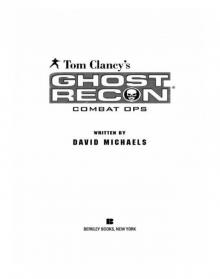 Combat Ops
Combat Ops Into the Storm: On the Ground in Iraq
Into the Storm: On the Ground in Iraq Under Fire
Under Fire Point of Impact
Point of Impact Red Rabbit
Red Rabbit Rainbow Six
Rainbow Six The Hunt for Red October
The Hunt for Red October The Teeth of the Tiger
The Teeth of the Tiger Conviction (2009)
Conviction (2009) Battle Ready
Battle Ready Patriot Games
Patriot Games The Sum of All Fears
The Sum of All Fears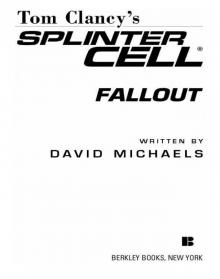 Fallout (2007)
Fallout (2007) Red Storm Rising
Red Storm Rising The Cardinal of the Kremlin
The Cardinal of the Kremlin Executive Orders
Executive Orders Lincoln, the unknown
Lincoln, the unknown Threat Vector
Threat Vector The Hunted
The Hunted Shadow Warriors: Inside the Special Forces
Shadow Warriors: Inside the Special Forces End Game
End Game Special Forces: A Guided Tour of U.S. Army Special Forces
Special Forces: A Guided Tour of U.S. Army Special Forces Locked On
Locked On Line of Sight
Line of Sight Tom Clancy Enemy Contact - Mike Maden
Tom Clancy Enemy Contact - Mike Maden Fighter Wing: A Guided Tour of an Air Force Combat Wing
Fighter Wing: A Guided Tour of an Air Force Combat Wing Springboard
Springboard Line of Sight - Mike Maden
Line of Sight - Mike Maden EndWar
EndWar Dead or Alive
Dead or Alive Tom Clancy Support and Defend
Tom Clancy Support and Defend Checkmate
Checkmate Command Authority
Command Authority Carrier: A Guided Tour of an Aircraft Carrier
Carrier: A Guided Tour of an Aircraft Carrier Blacklist Aftermath
Blacklist Aftermath Marine: A Guided Tour of a Marine Expeditionary Unit
Marine: A Guided Tour of a Marine Expeditionary Unit Commander-In-Chief
Commander-In-Chief Armored Cav: A Guided Tour of an Armored Cavalry Regiment
Armored Cav: A Guided Tour of an Armored Cavalry Regiment Tom Clancy's Jack Ryan Books 1-6
Tom Clancy's Jack Ryan Books 1-6 The Ultimate Escape
The Ultimate Escape Airborne: A Guided Tour of an Airborne Task Force
Airborne: A Guided Tour of an Airborne Task Force Debt of Honor
Debt of Honor Cyberspy
Cyberspy Point of Contact
Point of Contact Operation Barracuda (2005)
Operation Barracuda (2005) Choke Point
Choke Point Power and Empire
Power and Empire Every Man a Tiger: The Gulf War Air Campaign
Every Man a Tiger: The Gulf War Air Campaign Endgame (1998)
Endgame (1998) EndWar: The Missing
EndWar: The Missing Splinter Cell (2004)
Splinter Cell (2004) The Great Race
The Great Race True Faith and Allegiance
True Faith and Allegiance Deathworld
Deathworld Ghost Recon (2008)
Ghost Recon (2008) Duel Identity
Duel Identity Line of Control o-8
Line of Control o-8 The Hunt for Red October jr-3
The Hunt for Red October jr-3 Hidden Agendas nf-2
Hidden Agendas nf-2 Acts of War oc-4
Acts of War oc-4 Ruthless.Com pp-2
Ruthless.Com pp-2 Night Moves
Night Moves The Hounds of Rome - Mystery of a Fugitive Priest
The Hounds of Rome - Mystery of a Fugitive Priest Into the Storm: On the Ground in Iraq sic-1
Into the Storm: On the Ground in Iraq sic-1 Threat Vector jrj-4
Threat Vector jrj-4 Combat Ops gr-2
Combat Ops gr-2 Virtual Vandals nfe-1
Virtual Vandals nfe-1 Runaways nfe-16
Runaways nfe-16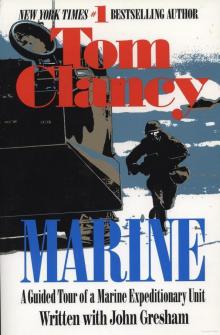 Marine: A Guided Tour of a Marine Expeditionary Unit tcml-4
Marine: A Guided Tour of a Marine Expeditionary Unit tcml-4 Shadow Warriors: Inside the Special Forces sic-3
Shadow Warriors: Inside the Special Forces sic-3 Jack Ryan Books 1-6
Jack Ryan Books 1-6 Cold Case nfe-15
Cold Case nfe-15 Changing of the Guard nf-8
Changing of the Guard nf-8 Splinter Cell sc-1
Splinter Cell sc-1 Battle Ready sic-4
Battle Ready sic-4 The Bear and the Dragon jrao-11
The Bear and the Dragon jrao-11 Fighter Wing: A Guided Tour of an Air Force Combat Wing tcml-3
Fighter Wing: A Guided Tour of an Air Force Combat Wing tcml-3 Patriot Games jr-1
Patriot Games jr-1 Jack Ryan Books 7-12
Jack Ryan Books 7-12 Mission of Honor o-9
Mission of Honor o-9 Private Lives nfe-9
Private Lives nfe-9 Operation Barracuda sc-2
Operation Barracuda sc-2 Cold War pp-5
Cold War pp-5 Point of Impact nf-5
Point of Impact nf-5 Red Rabbit jr-9
Red Rabbit jr-9 The Deadliest Game nfe-2
The Deadliest Game nfe-2 Springboard nf-9
Springboard nf-9 Safe House nfe-10
Safe House nfe-10 EndWar e-1
EndWar e-1 Duel Identity nfe-12
Duel Identity nfe-12 Deathworld nfe-13
Deathworld nfe-13 Politika pp-1
Politika pp-1 Rainbow Six jr-9
Rainbow Six jr-9 Tom Clancy's Power Plays 1 - 4
Tom Clancy's Power Plays 1 - 4 Endgame sc-6
Endgame sc-6 Executive Orders jr-7
Executive Orders jr-7 Net Force nf-1
Net Force nf-1 Call to Treason o-11
Call to Treason o-11 Locked On jrj-3
Locked On jrj-3 Against All Enemies
Against All Enemies The Sum of All Fears jr-7
The Sum of All Fears jr-7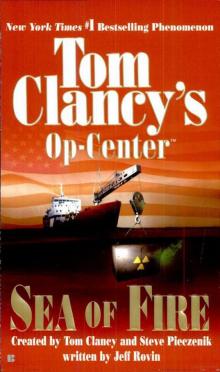 Sea of Fire o-10
Sea of Fire o-10 Fallout sc-4
Fallout sc-4 Balance of Power o-5
Balance of Power o-5 Shadow Watch pp-3
Shadow Watch pp-3 State of War nf-7
State of War nf-7 Wild Card pp-8
Wild Card pp-8 Games of State o-3
Games of State o-3 Death Match nfe-18
Death Match nfe-18 Against All Enemies mm-1
Against All Enemies mm-1 Every Man a Tiger: The Gulf War Air Campaign sic-2
Every Man a Tiger: The Gulf War Air Campaign sic-2 Cybernation nf-6
Cybernation nf-6 Support and Defend
Support and Defend Night Moves nf-3
Night Moves nf-3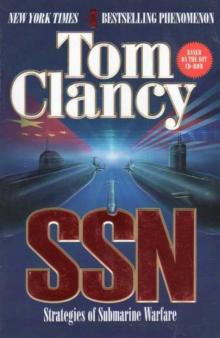 SSN
SSN Cutting Edge pp-6
Cutting Edge pp-6 The Cardinal of the Kremlin jrao-5
The Cardinal of the Kremlin jrao-5 War of Eagles o-12
War of Eagles o-12 Op-Center o-1
Op-Center o-1 Mirror Image o-2
Mirror Image o-2 The Archimedes Effect nf-10
The Archimedes Effect nf-10 Teeth of the Tiger jrj-1
Teeth of the Tiger jrj-1 Bio-Strike pp-4
Bio-Strike pp-4 State of Siege o-6
State of Siege o-6 Debt of Honor jr-6
Debt of Honor jr-6 Zero Hour pp-7
Zero Hour pp-7 Ghost Recon gr-1
Ghost Recon gr-1 Command Authority jr-10
Command Authority jr-10 Tom Clancy's Power Plays 5 - 8
Tom Clancy's Power Plays 5 - 8 Checkmate sc-3
Checkmate sc-3 Breaking Point nf-4
Breaking Point nf-4 Gameprey nfe-11
Gameprey nfe-11 The Hunted e-2
The Hunted e-2 Hidden Agendas
Hidden Agendas Divide and Conquer o-7
Divide and Conquer o-7